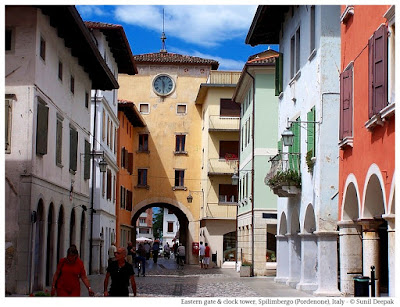History
There was an old castle in this area from the pre-Roman times. The city really grew and became important in the 11th century when the Count of Spengenberg from Austria came and settled here.
Till the arrival of Napoleon in north Italy in the 1790s, it was a part of the Republic of Venice. After a few years under the French rule of Napoleon, it came under the Autrian empire. It joined Italy in 1866.
The city was destroyed in 1976 in a terrible earthquake but since then it has been rebuilt. It is incredible that most of the old houses with their frescoes have been restored to their original glory.
Visiting The Town
It is a tiny city that you can easily cover in a couple of hours of walking. Close to the cathedral, towards the eastern edge of the town, there is a big parking area. You can leave your car there and start your visit from the Cathedral.
The Duomo (Cathedral), is dedicated to St. Mary. Its construction was started in 1284. It was also damaged in the earthquake of 1976 and has been restored. Its inner walls have some wonderful frescoes from 1300s, supposedly the works of an artist called Vitale of Bologna. If you like admiring art and medieval frescoes, you may wish to spend some time in exploring this cathedral.
Like the rest of the city, the outer walls of the Cathedral, still have a few frescoes, though most of them are lost. Still you can imagine how beautiful and imposing it must have looked when it was in its full glory.
The oldest parts of the Castle of the Counts of Spengenberg near the eastern gate of the medieval wall, are from 11th century. Over the centuries more buildings were added to them. It is built in a semicircle and it does not look like a castle. Rather, it is more like a series of noble houses with frescoes in different styles that vary from Romanic to Gothic to Renaissance. The Spengenberg family also gave the name to the city Spilimbergo. It is an amazing building in gentle colours, that somehow make me think of autumn.
You can also take this opportunity to visit San Daniele del Fruili, a few kilometres away, famous for its ham.
Conclusions
If you are on holidays at one of the towns on the Adriatic coast like Lignano, Bibione, Jesolo & Caorle and are looking for a day tour immersed in art and history, consider visiting Spilimbergo to admire its medieval houses with their wonderful frescoes. It is like an open-air museum.
Make sure to wear comfortable shoes for this trip, since walking on pebbled streets can be tough with high heels or thin-soled shoes.
***




















